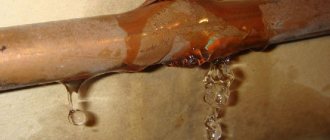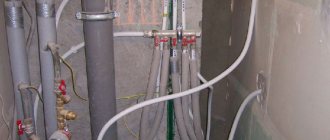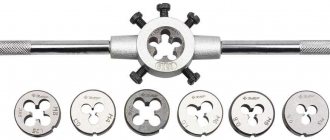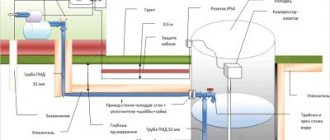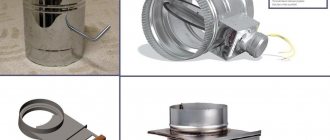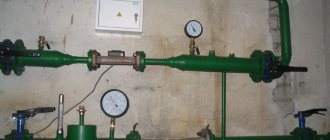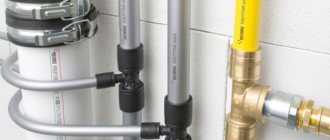What and how to seal a leak in a heating pipe?
Typically, steel pipes are used in heating systems. They withstand water pressure perfectly, wear out slowly and have a long useful life. Their main drawback, which negates all the listed advantages, is low corrosion resistance. Because of this, sooner or later a water leak may appear from the heating system, which will be quite difficult to repair.
Most people start looking for information on how to repair a leak in a heating pipe after a breakdown occurs. If immediate measures are not taken, the problem can become global, even leading to the replacement of the entire heating system. It is better to quickly resolve a “small” breakdown and check the pipes from time to time to prevent them from completely rupturing.
Possible causes of leakage
The reason for leaking metal pipes in the heating system is the destructive effects of corrosion. Water that constantly circulates inside, as well as changes in temperature and moisture outside, can cause rust. It quickly spreads over the surface, eating through the walls.
For those who do not know how to find a water leak in a heating system, it is enough to inspect the pipe and find places with corrosion.
They are already at risk, and the damage may not even be noticeable. If the surface is wet but other parts of the pipe are dry, repairs must begin immediately. In practice, the heating system may consist of polyethylene pipes, for which corrosion does not pose a danger. The risk of leakage is significantly less than in the previous version, but the reasons for its occurrence are also different.
The reason for leakage of polyethylene or polypropylene pipes is their improper installation and selection. Trying to save money, people often buy pipes designed for cold water. Under the influence of high temperatures, they are deformed and even melt, and eventually crack, releasing all the water out. If a similar situation arises, even soldering the heating pipes will not help, you need to change the entire system.
Even metal-plastic pipes are not protected from possible leaks. Cracks may appear at their joints, and sudden changes in temperature and humidity provoke wear and tear on their walls. If the first signs of a problem appear, you need to immediately repair the leak in the heating system so as not to harm yourself and your neighbors.
How to deal with a leak?
Once damage is discovered, it is not necessary to call a plumber - you can solve the problem yourself with a minimum of effort.
It will be quite difficult to shut off the supply of hot water to the heating system, so you need to patch the hole as efficiently as possible, focusing on major repairs in the future.
There are several ways to repair a hole in a heating pipe with your own hands:
- Bandage and cement. The basis for the future sealant will be a mixture of cement mortar with a medium consistency (like sour cream). To patch a crack, you need to cut a piece of medical bandage of such a size that you can wrap it around the pipe more than twice. It is soaked in the prepared mixture, and then the leak area is tightly bandaged. In order for a homemade bandage to withstand water pressure, you should use several pieces of bandage, placing them on top of each other. After this, the treated area is smeared with cement on top and allowed to dry. It will take a day for the concrete to completely harden. If you paint it on top, it will not only look beautiful, but will also provide additional strength to the entire structure.
- Salt. No matter how it sounds, salt is a good sealant for eliminating leaks in the heating system. If the damage is minor, just take a handful of salt in your hand and rub the crack with it. Very soon the water will stop dripping. In case of a large-scale breakdown, you can use the same medical bandage, additionally sprinkling it with salt after each turn. It will not be possible to achieve an ideal and long-lasting solution to the problem. The water will hold for a while until it cools. To protect yourself completely, you need to replace all damaged pipes with new ones.
- Bandage and rubber band. One of the most effective ways to stop a leak in a heating pipe is to install a durable bandage at the site of the damage. To do this, take a rubber inner tube from a bicycle or an elastic bandage for athletes and cut it into pieces, the width of which should be at least 10 cm. A homemade bandage is tightly wrapped around the damaged area on the surface of the pipe and secured with wire or several clamps. Such a bandage can withstand several heating seasons, however, this is only a temporary solution to the problem . In addition, when considering options for eliminating leaking heating pipes, it is worth paying attention to ready-made bandages that are sold as components. They can be made of several clamps and a rubber insert, or two plates connected with bolts. Manufacturers of such parts emphasize that their useful life is limited, and a damaged pipe must be replaced as quickly as possible.
- Cold welding. If soldering heating pipes with your own hands is not used due to the installation of the heating system, you can use cold welding. The surface of the pipe at the site of damage is cleaned of paint and other substances to bare metal using coarse sandpaper or a knife. The main thing is not to overdo it so that the crack does not increase. A one-component sealant for heating pipes is applied to the site of the breakdown immediately, a two-component one is first mixed well. The adhesive mixture is rubbed forcefully into the crack and the hand is not removed for several minutes until the substance dries.
- Sealant. To permanently get rid of problems with cracks in pipes, you can use a liquid sealant for the heating system. It is poured into a bucket or other container and mixed thoroughly. The heating system is filled with water to the maximum and several liters are drained, which correspond to the volume of the substance used. To seal all cracks, heating system sealant is poured into the pipes using a pump and free entry. After this, it should work for at least 7 hours at a temperature of 50-60 degrees and a pressure in the range of 1.2-1.6 bar. Thus, you can easily solve the question of how to seal a fistula in a heating pipe with maximum efficiency. Damaged areas are sealed from the inside, eliminating the need to replace pipes in the future.
What if a metal-plastic pipe bursts?
It is very rare, but it still happens, that metal-plastic pipes burst lengthwise. The best solution, of course, would be to completely replace such a pipe. But there are situations when this is impossible to do due to various circumstances. But the pipe lets water through, and some measures need to be taken.
Today there are two ways to temporarily block the flow of water from a burst pipe:
- make a bandage;
- use cold welding.
However, these methods are possible if the crack is of short length. A crack in a metal-plastic pipe can be closed by placing a piece of rubber on the damaged area, larger than the crack itself, on both sides by 2-3 cm. The rubber bandage is secured to the pipe using metal clamps, which are sold in hardware stores or, in extreme cases , you can use wire.
Small cracks can be repaired by cold welding. To do this, drain water from the damaged area to eliminate pressure from the inside on the patch. The pipe must be dry, after which the repair site is cleaned with sandpaper and welding compound is applied. It takes a day for the solution to dry completely, after which the pipeline can be used.
But you should remember that if a metal-plastic pipe bursts, then cold welding cannot always help. Its use depends on the pressure in the pipeline, water temperature and other factors. In conclusion, I would like to say that metal-plastic pipes cannot leak if the installation was carried out correctly, according to the recommended technologies, and the material was purchased of high quality.
Repair of metal-plastic pipes: causes and methods of eliminating leaks
Articles
Of all types of pipes used in everyday life, metal-plastic pipes are perhaps the most practical, so the need to repair metal-plastic pipes arises infrequently and is usually associated with poorly executed connections of pipeline elements. As a result of the latter, leaks may form at pipe joints.
Otherwise, the design of the pipes, which is a laser-welded aluminum pipe, protected both inside and outside by layers of polyethylene, is quite reliable; a leak in the body of a metal-plastic pipe can only occur under serious mechanical stress or if the bending radius of the metal-plastic pipe has not been observed according to the technology. Corrosion from condensate settling on a metal-plastic pipe is also impossible, since the outer layer of plastic provides excellent protection to the metal.
Leak in a metal-plastic pipe
Leaks, as a rule, occur due to problems with fittings for metal-plastic pipes or due to poor quality of the pipeline system.
How to work with metal-plastic pipes when a leak occurs from under a compression fitting? You should first try to simply tighten the nut along the thread, since, for example, compression fittings tend to loosen their “grip” over time (every 2-3 years).
If it is not possible to eliminate the leak in this way, then you will need to drain the water from the system and perform a more comprehensive check:
- Check to see if the O-ring between the fitting body and the fitting inserted into the pipe has been damaged (if the fitting is a compression fitting and not a press fitting).
- Find out whether the cut of the pipe itself is even.
- Determine whether the fitting gaskets on the fitting inserted into the pipe are worn.
Having identified the problem and eliminated it, they reassemble the pipeline elements, lubricating the connections with silicone (winding the threads with FUM tape).
Compression fitting design
Eliminating leaks in metal-plastic pipes connected by press fittings
It happens that a leak forms in pressed brass connections. This type of connection is assembled using an adjustable wrench, and if the nuts are tightened too tightly, this may deform the soft ring (the so-called olive) inside the fitting, which will certainly cause a leak.
Repair of a metal-plastic pipe in this case will consist of the following:
- You will need to disassemble the leaking end of the connection, remove the cap nut from the olive and remove the end of the pipe from the fitting.
- To cut an olive, you need to use a hacksaw. The end of the pipe should be cleaned with fine-grained glass sandpaper or ordinary wire wool. After this, you will need to put a new olive on the end of the pipe.
- The connection is then reassembled and the cap nut is manually tightened onto the fitting body. Make one full turn with the wrench and check the connection for waterproofing.
- If the connection is still leaking, the nut must be tightened about a quarter turn.
Advice!
The most correct solution when such a problem arises is to drain the water from the pipes, then cut off the fitting using a hacksaw and replace it with a tight-fitting coupling.
Coupling connection of metal-plastic pipes
Alternative Repair Methods
If the flow area of the fitting allows, and there is access to the pipes before and after the fitting, then another repair method is possible - bypassing the fitting using a copper tube of a suitable diameter.
To do this, the pipe is cut in accessible places before and after the leaking fitting, and fittings are installed on the ends of the pipes that go onto the threads. Then a shunt pipe is pulled through the emergency section, fittings for the shunt pipe made of copper are screwed onto the threads, and the connections are pressed.
If solder joints leak, drain water from the pipe, then dry it thoroughly with a hairdryer or blowtorch. The warm joint is lightly moistened with self-cleaning soldering flux, then the joint is reheated to melt the solder. At the same time, the flux promotes its penetration into existing voids and reliable sealing of the joint of metal-plastic pipes.
Repair of cracks and other defects in the body of a metal-plastic pipe
If a metal-plastic pipe bursts, then, naturally, it is better to immediately replace the failed element of the pipeline system. However, if this is not possible for any reason, temporary measures will need to be taken.
One of the repair methods in such cases may be the installation of a bandage. This method is very reliable and can sometimes last until the pipe bursts in another place. Probably the only thing that cannot be repaired with a bandage is a long crack in a metal-plastic pipe.
The repair process using a bandage is usually performed as follows:
- The bandage itself is prepared. You can purchase it or make it yourself. Metal clamps of a suitable diameter will work best for this.
- The length of the bandage is selected with a margin so that it protrudes on each side of the injury site by at least 2 cm.
- The area is covered with soft rubber 2-5 mm thick, after which a bandage is applied and secured.
Repairing leaks near fittings
Elimination of leaks in metal-plastic pipelines assembled using compression fittings
As a rule, leaks in metal-plastic pipes appear due to problems with connecting devices, namely fittings. To eliminate water leakage, sometimes it is enough to tighten the nut more tightly, since compression fittings tend to weaken the strength of the connection over time (frequency - once every 2-3 years).
The nuts need to be tightened periodically
If after this water continues to leak, you need to perform a thorough inspection of the system. To do this, drain the water from the pipeline and proceed according to the instructions:
- check the rubber sealing ring inserted between the fitting and the fitting body for damage;
- assess the degree of wear of the rubber gaskets on the fitting;
- inspect how smooth the pipe cut is.
Layout of the ferrule ring in the fitting
After fixing the problem, reassemble the pipeline, treating the joints with silicone grease and wrapping the threads with sealing material (for example, FUM tape).
Eliminating leaks in pipelines installed using press fittings
When using brass press fittings to assemble metal-plastic pipelines, an adjustable wrench is required. Installation of this connection involves tightening the nuts with slight force to a certain point.
Sometimes the nuts are tightened too tightly, which leads to the formation of defects in the soft ring located inside the press fitting, and, as a result, leaks.
If this is exactly what happened to you, repairing metal-plastic pipes with your own hands is done as follows:
Press fitting diagram
- dismantle the leaking connection: unscrew the cap nut, remove the end of the pipe from the fitting;
- remove the old soft ring from the fitting using a hacksaw, sand the pipe cut with a fine-grained sanding mesh (you can use a regular wire sponge), put the new ring on the pipe;
- reassemble the connection; tighten the cap nut located on the body of the connecting device with a wrench, making one full turn;
- check the waterproofing of the joint - if the leak is not eliminated, tighten the nut another 1/4 turn with a wrench.
How to repair a fistula on a pipe: heating or plumbing, various repair methods
The term “pipe fistula” refers to deformation changes in the form of a through hole in the pipeline. The main reason for the formation of this phenomenon on rolled pipes is considered to be pitting corrosion.
It is a clear signal that the pipe line needs urgent replacement. It is not always possible to perform a full range of pipe repairs with replacement, so it is only partially performed.
At the same time, we must not forget that such measures are temporary, and replacement of areas that have fallen into disrepair cannot be avoided anyway. You can use the help of professional craftsmen, or you can fix everything yourself.
How to eliminate an “accident”
To complete the installation you need to prepare the following tools:
- Drill.
- Bolts (set).
- Brush for cleaning rolled metal.
- BV-2 adhesive and epoxy adhesive type.
- Acetone and gasoline.
- Ketn.
- Putty knife.
Before sealing the fistula in the pipe, water is drained from the network. To do this, you need to close the stop valve and open each tap. The system should be free of residual water.
https://www.youtube.com/watch?v=ib0hSPxJQlc
Next, the size of the corrosion formation is determined. To do this, carefully remove the paint layer and rusty formation with sandpaper. A smooth surface should form in the area of the breakage.
After this, the cleaned area must be degreased with acetone. You can use gasoline for the same purpose. When sealing, this stage of action is very important.
When applying a bandage to a workpiece with an uneven surface, it is impossible to obtain the most airtight joint, and all sealing measures will have to be repeated again.
On a well-cleaned surface of the product, the amount of deformation can be accurately determined. And, guided by the information received, they determine how to further eliminate the deficiency. According to the form of formation, fistulas are divided into: point and elongated. Each of them is eliminated differently.
How is the work carried out?
Repair of fistulas on pipes is carried out using the following methods:
- Using a bolt. This method is used when it is necessary to seal a small hole. The hole is widened with a drill, and a thread is cut in the prepared hole. A prepared screw or self-tapping screw is screwed into it. In old highways it is not recommended to do this. The old age of used metal can lead to the appearance of a larger hole in the “problem” area.
- Bandage with rubber gasket. This method is universal because it is suitable for all pipes and any type of water leak. The bandage is selected depending on the size of the leak. It is recommended to use a rubber gasket, and a strip 0.5 cm larger than the bandage and a centimeter smaller than the circumference of the pipe is cut out of it. It is installed under it and the structure is placed on the fistula area. If it is not very large, then during repairs it is allowed not to interrupt the water supply.
- Repair with adhesive bandage. First you need to prepare a strip of fiberglass, or an ordinary bandage. The size of the tape should be such that it is enough to wrap the product six times. This ribbon is soaked with epoxy glue and wrapped so that the leak is located in the center. At the end, the bandage must be secured with a clamp. This pipe network will be able to function only a day after repair.
- Sealing by cold welding. This option is temporary. It is intended for small holes. Afterwards, it is better to repair the problem area using one of the more reliable methods. The described method is not durable due to the fact that the influence of water and high temperature on liquid welding leads to its weakening. To repair using cold welding, you simply need to apply it to the water leakage area that appears on the product.
In this article you will learn how to eliminate a fistula in a pressure pipeline.
Troubleshooting plastic products
A fistula on a plastic pipe is repaired in two ways: threaded and soldered.
The threaded method can only be used for products where thread cutting is possible. A piece of pipe line with a fistula that has become unusable is cut off with special scissors.
An insert is prepared from blanks of the required volume. On plastic materials, threads are cut with a tool. Then another structure is secured to the pipe network using fittings and couplings.
Welding on plastic pipe materials begins with cutting off the leaking area. After this, a fitting and a workpiece of the appropriate size are prepared.
A heated soldering iron for welding plastic pipes is used to heat the outer edges of the plastic and the inner edges of the fittings. At the final stage of repair, the prepared pipe is attached with fittings.
This should be done without delay, as plastic tends to harden instantly, and an incorrectly fastened structure cannot be remade again.
Repair of copper products
Copper pipe fistula is not a rare occurrence. Copper pipes have been used in construction for a very long time. They are not only suitable for all types of highways, but are also characterized by high ductility and resistance to corrosion.
Their service life is not limited, and they will easily last the entire period allotted to the house without breakdowns. But, sooner or later, situations arise when these products need to be repaired for fistula.
Copper systems are repaired by welding, which requires the participation of a specialist. To avoid the possibility of a large fistula, the network should be checked regularly. If any damage is noticed, it should be repaired immediately.
Repair of cracks and other defects in the body of a metal-plastic pipe
If a metal-plastic pipe bursts, then, naturally, it is better to immediately replace the failed element of the pipeline system. However, if this is not possible for any reason, temporary measures will need to be taken.
One of the repair methods in such cases may be the installation of a bandage. This method is very reliable and can sometimes last until the pipe bursts in another place. Probably the only thing that cannot be repaired with a bandage is a long crack in a metal-plastic pipe.
The repair process using a bandage is usually performed as follows:
- The bandage itself is prepared. You can purchase it or make it yourself. Metal clamps of a suitable diameter will work best for this.
- The length of the bandage is selected with a margin so that it protrudes on each side of the injury site by at least 2 cm.
- The area is covered with soft rubber 2-5 mm thick, after which a bandage is applied and secured.
Methods for making a bandage
Whether the problem area is subject to at least some repair will depend on how badly the metal-plastic pipe burst.
If the so-called fistula is small, you can try to seal it using cold welding.
To do this, release the pipe from pressure, wipe the problem area dry, clean it with fine sandpaper and, having prepared a cold welding solution, cover the gap. The pipe will be ready for further use approximately a day after applying the solution.
Advice!
However, it should be remembered that cold welding will not help in every case, since everything will depend on specific conditions, for example, the pressure in the pipe, the temperature of the water in it, etc.
A metal-plastic pipe will never leak if high-quality materials, professional installation and proper pipeline maintenance have been used. And remember that the correct bending of metal-plastic pipes is carried out using a special spring and at an angle of at least 45 degrees, depending on the diameter of the pipe.
If you follow the above rules, repairing metal-plastic pipes in your apartment will be an extremely rare occurrence.
Did you like the article? Subscribe to our Yandex.Zen channel
What to do if a leak occurs at the junction of pipes with each other?
In most situations, the cause of this problem is fittings, as well as poorly performed work on the pipeline arrangement.
If water begins to leak through the compression fitting
, then first of all you need to make sure that the fitting has not loosened during operation. As a rule, once every two or three years it is necessary to tighten the nut along the thread to prevent leakage.
After this, you can take other actions if the leak still remains. A comprehensive pipeline inspection includes a number of activities. To carry them out, it is necessary to free the pipeline from water, and only then check the following elements of the pipeline:
- O-rings located in the fitting;
- pipe cut and its evenness;
- gaskets in fittings that wear out over time.
After identifying the cause of the leak, it must be eliminated and all pipeline elements must be reassembled, replacing the elements that have become unusable. During the assembly process, all connections must be coated with silicone, and the threads must be wound with FUM tape.
If a leak occurs in pressed brass fittings
, then you will need an adjustable wrench, since one of the reasons for water leaking through the fitting is that the nut is too tight. As a result of this, the so-called olive located in the fitting becomes deformed and causes leakage.
If this is the reason, then you need to repair the metal-plastic pipe. For this:
- the leaking connection is disassembled;
- the cap-shaped nut is removed from the deformed soft ring, and the pipe is removed from the fitting;
- Using a hacksaw, the soft ring is cut off and the end of the pipe is cleaned; for this you can use a wire wool or fine-grained glass sandpaper, then a new ring is put on the pipe;
- the disassembled connection is reassembled, and the nut is first tightened by hand;
- after this, make one turn with the wrench and check how strong the waterproofing is;
- if the leak remains, then the nut needs to be tightened another quarter of a turn.
When performing work, be sure to drain the water and cut the fittings with a hacksaw, replacing them with couplings with a fairly tight fit.
